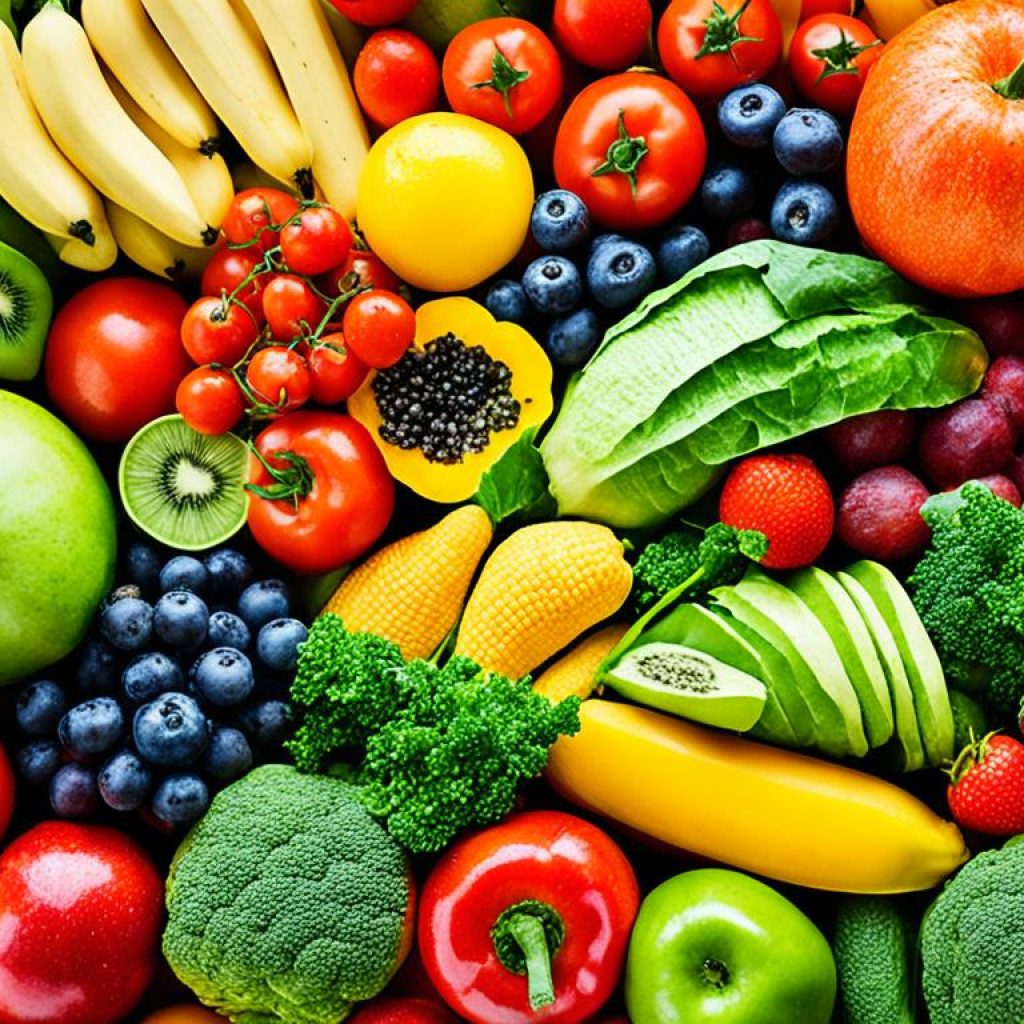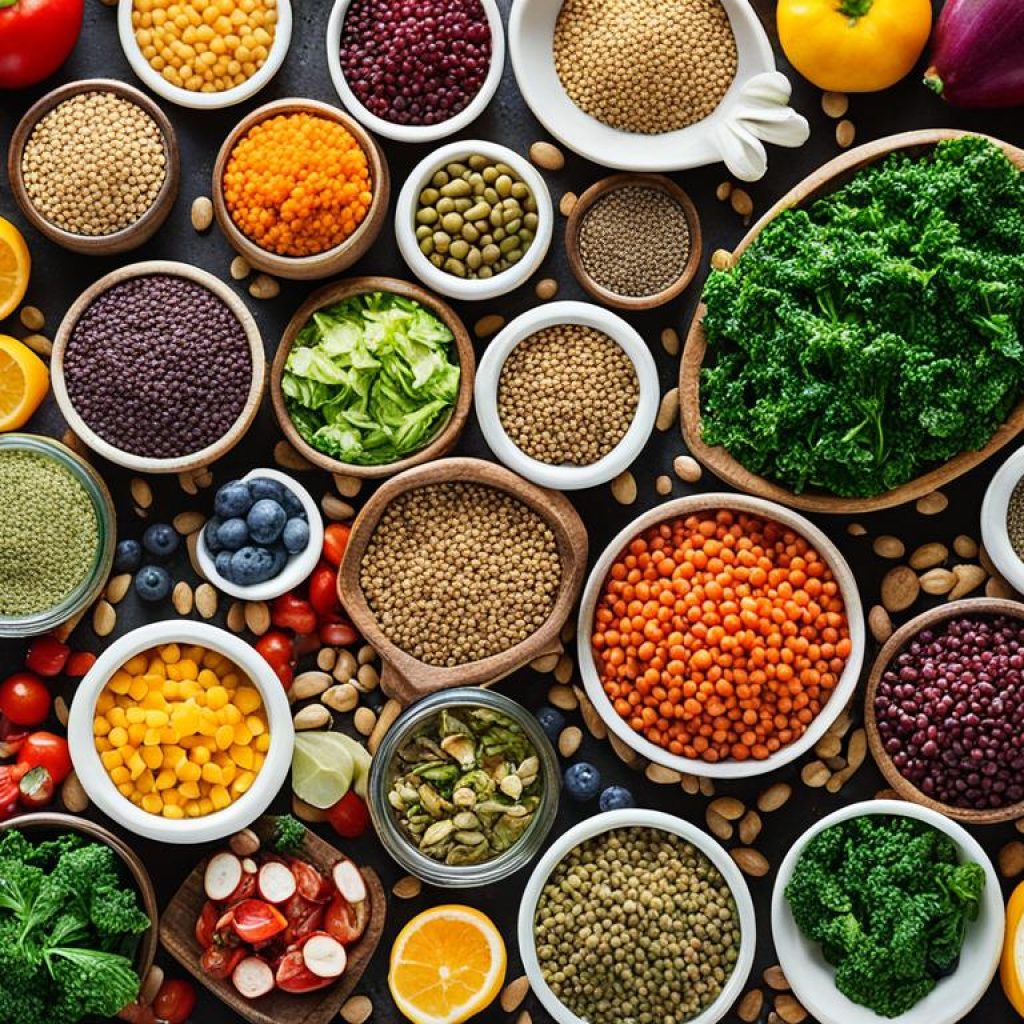“The greatest wealth is health.” – Virgil
Welcome to an insightful journey into the world of healthy eating on a budget. As Virgil once said, our health is our most precious asset. In today’s fast-paced world, it is more important than ever to prioritize our well-being, both physically and financially.
Eating nutritious food doesn’t have to cost a fortune. With the right knowledge and strategies, you can nourish your body and optimize your health without breaking the bank. In this article, we will explore budget-friendly approaches to healthy eating that will empower you to make smart choices for yourself and your loved ones.
From understanding the benefits of healthy eating to planning cost-effective meals and discovering affordable ingredients, we will provide you with practical insights and easy-to-implement tips. By the end of this journey, you will not only have a clearer understanding of how to eat healthily on a budget but will also feel motivated and inspired to embrace this lifestyle for the long term.
So, let’s dive in and explore how you can prioritize your health and well-being while being mindful of your finances. Together, we will uncover the secrets to creating delicious, nutritious, and pocket-friendly meals that will improve your overall health and vitality.
Key Takeaways:
- Healthy eating can be achieved on a budget.
- Prioritizing your health is a valuable long-term investment.
- Understanding the benefits of healthy eating can provide motivation for making positive changes.
- Planning meals and shopping strategically can help optimize your budget while nourishing your body.
- There are a variety of affordable ingredients and recipes that promote good health without straining your finances.
Benefits of Healthy Eating
Eating a balanced and nutritious diet has numerous benefits for our overall health and well-being. By prioritizing healthy eating, we can improve our physical and mental well-being, boost our energy levels, and effectively manage our weight. Here are some key advantages of making healthy food choices:
- Improved Overall Health: A diet rich in fruits, vegetables, whole grains, lean proteins, and healthy fats provides essential nutrients, vitamins, and minerals that support our immune system, enhance brain function, and reduce the risk of chronic diseases such as heart disease, diabetes, and certain types of cancer.
- Increased Energy Levels: Healthy eating helps fuel our bodies effectively, providing the necessary energy to carry out daily activities. Nutrient-dense foods such as complex carbohydrates, proteins, and healthy fats can sustain energy levels throughout the day, reducing feelings of fatigue and improving productivity.
- Better Weight Management: Incorporating nutritious foods into our diet can help maintain a healthy weight or achieve weight loss goals. Healthy eating promotes portion control, regulates appetite, and supports the body’s natural metabolism, making it easier to manage weight and reduce the risk of obesity.
By adopting healthy eating habits, we can enjoy these and many more benefits that contribute to our overall quality of life. Making conscious choices about the food we consume can have a profound impact on our physical and mental well-being.
The Importance of a Balanced Diet
One key aspect of healthy eating is maintaining a balanced diet. This means consuming a variety of foods from different food groups to ensure we get all the necessary nutrients for optimal health. A balanced diet typically includes:
- Leafy greens and colorful vegetables for vitamins, minerals, and fiber.
- Whole grains such as whole wheat, brown rice, and oats for complex carbohydrates.
- Lean proteins like chicken, fish, tofu, and legumes for essential amino acids.
- Healthy fats from sources like avocados, nuts, and olive oil.
- Natural sugars from fruits.
| Nutrient | Food Sources |
|---|---|
| Protein | Chicken breast, salmon, tofu, lentils |
| Vitamins | Spinach, kale, oranges, carrots |
| Minerals | Broccoli, almonds, sweet potatoes, beans |
| Fiber | Whole grains, berries, nuts, lentils |
| Healthy Fats | Avocado, olive oil, salmon, chia seeds |
By incorporating a variety of these foods into our meals, we can ensure a well-rounded diet that promotes optimal health and wellness.
Incorporating healthy eating habits into your lifestyle is an investment in your long-term well-being. By fueling your body with nutritious foods, you can enjoy improved overall health, increased energy, and better weight management. Remember, every meal is an opportunity to nourish your body and take care of yourself.
Understanding Budget-Friendly Nutrition
When it comes to embracing a healthy eating lifestyle, many people worry about the potential impact on their budget. However, eating nutritiously doesn’t have to break the bank. With a strategic approach and a focus on budget-friendly nutrition, you can make nutritious choices while keeping costs low.
One of the key factors in budget-friendly nutrition is prioritizing nutrient-rich foods. Instead of focusing on expensive and extravagant options, it’s important to choose foods that provide the most bang for your buck in terms of nutritional value. These foods typically include fruits, vegetables, whole grains, lean proteins, and legumes.
By incorporating budget-friendly staples into your meals, such as beans, lentils, oats, and frozen fruits and vegetables, you can ensure that your diet remains affordable without compromising on nutrition. These items are not only cost-effective but also packed with essential vitamins, minerals, and fiber.
“Eating nutritiously doesn’t have to break the bank. With a strategic approach and a focus on budget-friendly nutrition, you can make nutritious choices while keeping costs low.”
“Eating healthy on a budget is all about making smart choices. Instead of spending money on processed and convenience foods, opt for whole, unprocessed ingredients. Not only will this save you money in the long run, but it will also contribute to a healthier lifestyle.”
– Nutritionist Emily Roberts
Another essential aspect of budget-friendly nutrition is meal planning. By planning your meals in advance, you can save money by buying only the necessary ingredients and minimizing food waste. Additionally, meal planning allows you to take advantage of sales and discounts, helping you stretch your budget further.
“One of the key factors in budget-friendly nutrition is prioritizing nutrient-rich foods.”
To illustrate the advantages of budget-friendly nutrition, let’s take a look at an example meal plan that maximizes nutrition while being mindful of cost:
| Meal | Ingredients | Cost |
|---|---|---|
| Breakfast | Oatmeal with sliced banana and a sprinkle of cinnamon | $0.50 |
| Lunch | Vegetable stir-fry with brown rice | $2.00 |
| Dinner | Baked chicken breast with roasted vegetables | $3.50 |
| Snack | Carrot sticks with hummus | $1.00 |
This meal plan combines budget-friendly ingredients to create nutrient-rich and delicious meals throughout the day. As you can see, it’s possible to eat well on a limited budget by prioritizing nourishing foods and employing smart meal planning techniques.
In the next section, we will delve deeper into the topic of planning for cost-effective meals, providing you with valuable tips and strategies to optimize your budget-friendly nutrition approach.

Planning for Cost-Effective Meals
When it comes to maintaining a healthy diet on a budget, meal planning is a game-changer. By strategically organizing your meals in advance, you can ensure that you’re making the most of your ingredients and avoiding unnecessary expenses. In this section, I’ll share some valuable tips and strategies for designing affordable and nutritious meal plans.
1. Set a Budget
Before you start planning your meals, it’s important to establish a budget. Determine how much you can afford to spend on groceries each week or month. By setting a limit, you can make informed decisions about the ingredients and recipes that align with your cost-effective eating habits.
2. Embrace Plant-Based Proteins
Protein tends to be one of the more expensive components of a meal. However, you don’t need to rely solely on meat to meet your protein needs. Plant-based proteins like beans, lentils, tofu, and quinoa are affordable alternatives that pack a nutritional punch. Incorporating these ingredients into your meal plans can significantly reduce costs without compromising on essential nutrients.
3. Buy in Bulk
Buying pantry staples in bulk can be a cost-effective approach to meal planning. Items like rice, pasta, oats, and canned goods have a long shelf life and can be purchased in larger quantities for a lower price per unit. Be mindful of your storage space and only stock up on items you use regularly to avoid wastage.
4. Optimize Seasonal Produce
Eating fruits and vegetables that are in season can help you save money and enjoy better flavor. Seasonal produce tends to be less expensive and more readily available. At the same time, it provides essential vitamins, minerals, and antioxidants necessary for a balanced diet. Consider making a list of seasonal fruits and vegetables and plan your meals around them to create delicious and economical dishes.
5. Plan for Leftovers
Intentionally cooking larger portions can result in delicious leftovers that can be enjoyed for multiple meals. By incorporating planned leftovers into your meal planning, you can stretch your ingredients further and minimize food waste. Get creative with repurposing ingredients into new dishes or simply enjoy the same meal for lunch the following day.
6. Shop with a List
One of the most effective ways to stick to an economical meal plan is to shop with a list. Having a detailed list of the ingredients you need for your planned meals ensures that you only purchase what is necessary, reducing the chances of impulse buying. Additionally, it helps you stay organized and ensures that you don’t forget any crucial ingredients.
7. Explore Affordable Recipes
There are countless budget-friendly recipes available online that offer a combination of affordability and nutrition. Look for recipes that utilize affordable ingredients and require minimal prep time. By experimenting with different recipes, you can add variety to your meals while staying within your budget.
| Meal | Main Ingredient | Approximate Cost |
|---|---|---|
| Vegetable Stir-Fry | Mixed Vegetables | $3 |
| Black Bean Tacos | Black Beans | $5 |
| Chickpea Curry | Chickpeas | $4 |
| Quinoa Salad | Quinoa | $6 |
| Sweet Potato Burritos | Sweet Potatoes | $5 |
8. Make Use of Canned and Frozen Foods
Canned and frozen foods can be cost-effective options for meal planning. These items often have a longer shelf life and are available at lower prices compared to fresh alternatives. Stock up on canned vegetables, beans, and frozen fruits to have convenient ingredients on hand when you need them.
9. Cook at Home
Eating out or ordering takeout can quickly add up and strain your budget. Cooking at home allows you to have control over the ingredients used and portion sizes. Invest in simple cooking tools and experiment with homemade sauces and dressings to elevate your meals without spending a fortune.
With these practical tips and strategies for cost-effective meal planning, you can make healthy eating a sustainable lifestyle choice that doesn’t break the bank.
Smart Food Shopping for Health
When it comes to maintaining a healthy diet, smart food shopping plays a crucial role. By making informed decisions at the grocery store, you can ensure that you are purchasing nutritious ingredients while staying within your budget. Here are some tips to help you shop smartly for health:
- Create a Shopping List: Before heading to the store, take some time to plan your meals for the week and make a detailed shopping list. This will help you stay focused and avoid unnecessary purchases.
- Shop the Perimeter: The outer aisles of the grocery store are typically where you’ll find fresh produce, lean proteins, and dairy products. Try to spend the majority of your time in these areas to avoid the temptation of processed foods.
- Compare Prices: Take a moment to compare prices and brands to find the best value for your money. Sometimes, store brands or generic options can be just as nutritious as name brands but at a lower cost.
- Utilize Sales and Discounts: Keep an eye out for sales, discounts, and coupons to maximize your savings. Stock up on non-perishable items when they are on sale so that you always have healthy options available.
- Buy in Bulk: Purchasing items in bulk can often be more cost-effective. Consider buying staple ingredients like grains, beans, and nuts in larger quantities to save money in the long run.
Remember, shopping smartly for health doesn’t mean compromising on quality. With a little planning and these tips in mind, you can fill your cart with nutritious foods without breaking the bank.
Comparison of Nutritious and Budget-Friendly Ingredients
| Ingredient | Nutritional Benefits | Cost |
|---|---|---|
| Spinach | High in iron, vitamins A and C | Low |
| Quinoa | Good source of protein and fiber | Moderate |
| Canned beans | Rich in protein and fiber | Low |
| Oats | High in fiber and antioxidants | Low |
| Frozen berries | Packed with antioxidants and vitamins | Moderate |
| Peanut butter | Good source of healthy fats and protein | Low |
By choosing ingredients like spinach, quinoa, canned beans, oats, frozen berries, and peanut butter, you can enjoy nutritious meals without breaking the bank. Don’t forget to check out the Smart Food Shopping for Health table below for more budget-friendly ingredient ideas.

Best Budget-Friendly Recipes for Health
When it comes to maintaining a healthy diet on a tight budget, finding delicious and nutritious recipes that won’t break the bank is essential. With a little creativity and some smart shopping, you can enjoy flavorful meals that prioritize your health without straining your finances. Here are some of the best budget-friendly recipes for health that you can easily prepare at home:
1. Quinoa Salad with Roasted Vegetables
This hearty and colorful salad is packed with nutrient-rich ingredients and is perfect for a light lunch or side dish. Simply toss cooked quinoa with a medley of roasted vegetables such as bell peppers, zucchini, and cherry tomatoes. Dress it up with a tangy vinaigrette made from olive oil, lemon juice, and herbs for a burst of refreshing flavors.
2. Black Bean Tacos with Avocado Salsa
These vegetarian tacos are not only delicious but also affordable. Fill soft tortillas with seasoned black beans, crunchy lettuce, and a zesty avocado salsa. The combination of protein-packed black beans and creamy avocado provides a satisfying and nutritious meal that won’t stretch your budget.
3. One-Pot Lentil Soup
A comforting and hearty lentil soup is not only easy to make but also budget-friendly. In a single pot, simmer lentils with aromatic vegetables like onions, carrots, and celery, along with flavorful herbs and spices. This warm and nourishing soup is a great option for a quick and inexpensive dinner.
4. Sweet Potato and Chickpea Curry
Curries are a fantastic way to incorporate affordable ingredients while adding a burst of flavor to your meals. This sweet potato and chickpea curry combines tender sweet potatoes and protein-rich chickpeas with a fragrant blend of spices and creamy coconut milk. Serve it over steamed rice for a filling and satisfying dinner.
5. Oatmeal with Fresh Berries
Start your day off right with a nourishing bowl of oatmeal topped with a medley of fresh berries. Oats are not only a budget-friendly option but also packed with fiber and essential nutrients. Add a sprinkle of cinnamon and a drizzle of honey for extra natural sweetness to kickstart your morning.
“Eating well doesn’t have to be expensive. With these budget-friendly recipes, you can prioritize your health without breaking the bank.”
These budget-friendly recipes showcase how you can prepare delicious and nutritious meals while staying within your financial means. By incorporating affordable ingredients and utilizing smart cooking techniques, you can enjoy a wholesome diet that supports your well-being without straining your wallet.
Tips for Saving Money on Healthy Eating
When it comes to maintaining a healthy eating routine, cost can sometimes be a deterrent. However, with a few smart strategies, you can enjoy nutritious meals without breaking the bank. Here are some practical tips for saving money while prioritizing your health:
- Buy in bulk: Purchasing staple items in bulk can help you save significantly over time. Stock up on pantry essentials like grains, beans, and nuts, as well as frozen fruits and vegetables.
- Utilize leftovers: Get creative with leftovers and transform them into new meals. Repurpose cooked chicken into salads or sandwiches, or incorporate extra vegetables into stir-fries or omelettes.
- Minimize food waste: Plan your meals in advance and shop with a list to avoid buying more than you need. Also, consider freezing excess produce or herbs to prevent spoilage and preserve their freshness.
- Compare prices: Take the time to compare prices at different grocery stores or online platforms to find the best deals. Don’t forget to consider discount stores, farmer’s markets, or local stores for affordable options.
- Cook at home: Eating out can quickly add up, so try to cook meals at home as often as possible. Experiment with simple recipes using affordable ingredients, and you’ll be amazed at how much you can save.
- Embrace plant-based options: Plant-based proteins such as lentils, tofu, or chickpeas are often more budget-friendly than meat or poultry. Incorporating these alternatives into your meals can help stretch your budget while providing essential nutrients.
Expert Tip: Make a Shopping List and Stick to It
“One key tip for saving money on healthy eating is to make a shopping list before heading to the store and commit to sticking to it. Impulsive purchases and unnecessary items can quickly add up, so having a clear plan in place can help you stay on track and within your budget.” – Nutritionist Sarah Johnson

By implementing these tips, you can make significant savings while still prioritizing your health. Remember, healthy eating doesn’t have to be expensive – it’s all about being mindful, planning ahead, and making smart choices.
Incorporating Affordable Superfoods
When it comes to maintaining a nutritious diet on a budget, incorporating affordable superfoods into your meals can be a game-changer. These nutrient-packed ingredients not only provide exceptional health benefits but also help stretch your dollar further. Here are some affordable superfoods that will nourish your body without straining your budget:
1. Lentils
Lentils are a versatile and budget-friendly source of plant-based protein. Packed with fiber, iron, and antioxidants, they are a nutritious addition to any meal. From soups and stews to salads and side dishes, lentils can be used in a variety of recipes to add flavor, texture, and a nutritional boost.
2. Spinach
Spinach is a nutrient powerhouse that can be purchased at an affordable price. Rich in vitamins A, C, and K, as well as iron and calcium, spinach is a leafy green that offers a host of health benefits. Add it to salads, smoothies, stir-fries, or pasta dishes for an easy and budget-friendly way to increase your nutrient intake.
3. Quinoa
Quinoa is a nutritious grain that is not only high in protein but also gluten-free. While it may be slightly more expensive compared to other grains, its nutritional value makes it worth the investment. Use quinoa as a base for salads, as a stuffing for stuffed peppers, or even as a substitute for rice or pasta in various recipes.
4. Oats
Oats are a budget-friendly pantry staple that offers numerous health benefits. High in fiber, oats can help improve digestion, regulate blood sugar levels, and promote heart health. Enjoy a bowl of oatmeal for breakfast, or use oats to make homemade granola or energy bars for a nutritious and affordable snack.
5. Canned Tuna
Canned tuna is an affordable and convenient source of lean protein. It is also rich in omega-3 fatty acids, which support heart health and brain function. Use canned tuna in salads, sandwiches, or as a topping for whole wheat crackers for a quick and nutritious meal or snack.
By incorporating these affordable superfoods into your meals, you can create delicious and nutritious dishes without breaking the bank. Experiment with different recipes and combinations to find the ones that suit your taste preferences and budgetary needs.
| Superfood | Nutritional Benefits | Affordability |
|---|---|---|
| Lentils | Plant-based protein, fiber, iron, antioxidants | Highly affordable |
| Spinach | Vitamins A, C, and K, iron, calcium | Highly affordable |
| Quinoa | Protein, gluten-free, fiber | Relatively affordable |
| Oats | Fiber, blood sugar regulation, heart health | Highly affordable |
| Canned Tuna | Lean protein, omega-3 fatty acids | Highly affordable |
As you can see from the table above, these affordable superfoods offer a range of nutritional benefits at a reasonable price. Don’t let a limited budget discourage you from prioritizing your health. With some creativity and strategic planning, you can enjoy nutritious meals that are both affordable and delicious.

Making the Most of Seasonal Produce
When it comes to eating well without breaking the bank, incorporating seasonal produce into your meal plans is a smart and budget-friendly choice. Seasonal fruits and vegetables offer several benefits, including enhanced flavor, increased nutritional value, and lower prices. By embracing what nature has to offer during each season, you can create delicious and nutritious meals while keeping your grocery expenses in check.
When fruits and vegetables are in season, they are at their peak freshness and taste. This means that not only do they provide a burst of flavor to your dishes, but they also contain higher levels of essential nutrients. Seasonal produce is often harvested locally, reducing transportation costs and ensuring that you’re getting the freshest ingredients possible.
One way to take advantage of seasonal produce is to plan your meals around what’s available during a particular time of year. For example, during the summer months, you can enjoy an abundance of juicy berries, refreshing watermelon, and crisp cucumbers. In the fall, hearty vegetables like pumpkins, squash, and sweet potatoes take center stage.
To give you an idea of what’s in season throughout the year, here’s a handy guide:
| Season | Produce |
|---|---|
| Spring | Asparagus, strawberries, peas, radishes, spinach |
| Summer | Tomatoes, cucumbers, bell peppers, blueberries, watermelon |
| Fall | Pumpkin, butternut squash, apples, pears, Brussels sprouts |
| Winter | Citrus fruits, kale, carrots, winter squash, broccoli |
By planning your meals around seasonal produce, you not only save money but also support local farmers and reduce your carbon footprint. In addition to buying fresh produce, you can consider freezing or preserving excess fruits and vegetables when they are in abundance. This way, you can enjoy the flavors of the season even when they are no longer readily available.
Remember, eating well doesn’t have to be expensive. Take advantage of the variety and affordability of seasonal produce to create delicious and nourishing meals that won’t break the bank.
Whether you’re whipping up a refreshing summer salad or savoring a comforting winter stew, incorporating seasonal produce into your cooking is a great way to eat healthily while keeping costs down.
Budget-Friendly Snacking Options
When it comes to maintaining healthy eating habits on a budget, snacking can be a challenge. Many pre-packaged snacks are not only expensive but also packed with unhealthy additives. However, with a little creativity and planning, you can enjoy nutritious snacks without breaking the bank. Here are some budget-friendly snacking alternatives that you can easily prepare at home:
1. Fresh Fruit Salad
Instead of reaching for expensive pre-cut fruit cups, opt for a colorful and refreshing fruit salad. Choose seasonal fruits to keep costs low and experiment with different combinations to add variety to your snacks.
2. Homemade Trail Mix
Create your own trail mix by combining affordable ingredients like nuts, seeds, dried fruits, and whole grain cereal. This DIY snack is not only cost-effective but also allows you to control the portion size and customize the flavors to your liking.
3. Veggie Sticks with Hummus
Vegetables like carrots, celery, and bell peppers are not only nutritious but also budget-friendly. Pair them with a homemade hummus dip made from chickpeas, olive oil, and spices for a satisfying and fiber-rich snack.
4. Yogurt Parfait
Instead of buying individual yogurt cups with added sugars, opt for a homemade yogurt parfait. Layer plain yogurt with fresh or frozen fruits, a sprinkle of granola, and a drizzle of honey for a tasty and budget-friendly snack option.
5. Rice Cakes with Nut Butter
Rice cakes are an affordable and versatile snack base. Top them with natural nut butter, such as peanut or almond butter, for a creamy and protein-packed treat that will keep you satisfied between meals.
| Snack Option | Benefits |
|---|---|
| Fresh Fruit Salad | Provides essential vitamins, minerals, and antioxidants. Hydrating and low in calories. |
| Homemade Trail Mix | Offers a mix of healthy fats, protein, and fiber. Provides sustained energy. |
| Veggie Sticks with Hummus | Packs vitamins, minerals, and fiber. Supports satiety and promotes digestive health. |
| Yogurt Parfait | Supplies protein, calcium, and probiotics. Promotes gut health and muscle recovery. |
| Rice Cakes with Nut Butter | Combines carbohydrates, protein, and healthy fats. Provides energy and satiety. |
By opting for these budget-friendly snacking options, you can nourish your body with nutritious foods without compromising your wallet. Take the time to plan and prepare these snacks ahead of time, so you always have a healthy option at your fingertips.
Staying Motivated on a Budget
When it comes to maintaining a healthy eating routine on a budget, motivation plays a crucial role. It’s easy to feel discouraged or overwhelmed by the perceived expense of nutritious meals, but with the right mindset and strategies, you can stay committed to eating well without breaking the bank.
One of the key factors in staying motivated is to remind yourself of the long-term benefits of healthy eating. Not only does it contribute to your overall well-being and help prevent chronic diseases, but it also improves your energy levels, mood, and productivity.
“Investing in your health now will save you money on medical bills in the future.”
Remember that maintaining a healthy diet doesn’t have to be an all-or-nothing approach. You can start small by making gradual changes and focusing on incorporating nutritious foods into your meals. Celebrate each small achievement and use it as fuel to keep going.
Setting achievable goals is another effective way to stay motivated. Start by setting specific and measurable targets, such as including a certain number of servings of fruits and vegetables in your daily meals or cooking homemade meals a certain number of times per week. Keep track of your progress and reward yourself when you reach milestones.
As with any journey, it’s essential to have a support system. Surround yourself with like-minded individuals who are also focused on eating well on a budget. Share your challenges, successes, and recipe ideas with them. The encouragement and accountability from others can help you stay on track and motivated.
Lastly, don’t forget to give yourself some flexibility. It’s okay to indulge in your favorite treats occasionally or have a budget-friendly “cheat meal”. The key is to strike a balance and make mindful choices most of the time.
Remember, eating well without breaking the bank is not only possible but also beneficial for your long-term health and well-being. Stay motivated, stay focused, and enjoy the journey of nourishing your body with nutritious and affordable meals.
Tips for Staying Motivated on a Budget
| Tip | Description |
|---|---|
| 1 | Remind yourself of the long-term benefits of healthy eating |
| 2 | Start small and celebrate each achievement |
| 3 | Set achievable goals and track your progress |
| 4 | Build a support system of like-minded individuals |
| 5 | Allow for flexibility and occasional indulgences |
Conclusion
In conclusion, maintaining a healthy eating routine on a budget is not only possible but also incredibly beneficial for our overall well-being. By prioritizing nutrient-rich foods and implementing cost-effective strategies, we can nourish our bodies without breaking the bank.
Throughout this article, we have explored the numerous advantages of healthy eating, including improved health, increased energy levels, and better weight management. We have also discussed the importance of understanding budget-friendly nutrition and planning for cost-effective meals.
Furthermore, we have provided practical tips for smart food shopping, highlighted budget-friendly recipes that are both delicious and nutritious, and shared ideas for saving money on healthy eating. Additionally, we have emphasized the value of incorporating affordable superfoods, utilizing seasonal produce, and opting for budget-friendly snacking alternatives.
It is my hope that this article has equipped you with valuable insights and actionable strategies to embrace healthy eating on a budget. Let us remember that the journey towards a nourished and balanced lifestyle starts with small, consistent steps. So, take charge of your health and begin implementing these tips today. Your body and wallet will thank you!
FAQ
What is healthy eating on a budget?
Healthy eating on a budget refers to maintaining a nutritious diet while being mindful of cost. It involves making smart food choices that provide optimal nutrition without breaking the bank.
What are the benefits of healthy eating?
Healthy eating offers numerous benefits, including improved overall health, increased energy levels, better weight management, and a reduced risk of chronic diseases like heart disease, diabetes, and certain cancers.
How can I approach nutrition from a budget-friendly perspective?
To practice budget-friendly nutrition, focus on prioritizing nutrient-rich foods like fruits, vegetables, whole grains, lean proteins, and healthy fats. These foods provide essential vitamins and minerals without being overly expensive.
How can I plan cost-effective meals?
Planning meals in advance and creating a grocery list are key to cost-effective eating habits. Design meal plans around affordable ingredients, utilize leftovers creatively, and consider batch cooking to save time and money.
How can I shop smartly for healthy ingredients?
When shopping for healthy ingredients, compare prices, take advantage of sales and discounts, buy in bulk for non-perishable items, and consider purchasing store brands, which are often more budget-friendly.
What are some budget-friendly recipes for health?
There are plenty of delicious and nutritious recipes that can be prepared on a budget. Some examples include vegetable stir-fries, bean-based soups or stews, homemade granola bars, and roasted vegetable salads.
How can I save money on healthy eating?
To save money on healthy eating, buy ingredients in bulk, cook at home instead of eating out, minimize food waste by using leftovers creatively, and consider planting and growing your own vegetables and herbs.
What are some affordable superfoods?
Affordable superfoods include oats, sweet potatoes, lentils, canned tuna, eggs, and frozen fruits and vegetables. These options offer excellent nutritional value and can be incorporated into various meals without breaking the bank.
How can I incorporate seasonal produce into my meals?
Incorporating seasonal produce into your meals is a great way to save money. Visit your local farmers’ market or grocery store to find fresh and affordable fruits and vegetables that are in season, and create dishes that highlight those ingredients.
What are some budget-friendly snacking options?
Budget-friendly snacking options include homemade trail mix, sliced fruits and vegetables with hummus or yogurt dip, oatmeal energy balls, and air-popped popcorn. These snacks are nutritious, easy to prepare, and cost-effective.
How can I stay motivated to eat healthy on a budget?
Staying motivated to eat healthy on a budget requires focusing on the long-term benefits, such as improved well-being and increased energy levels. It can also help to set realistic goals, track progress, and find support from friends or online communities.

